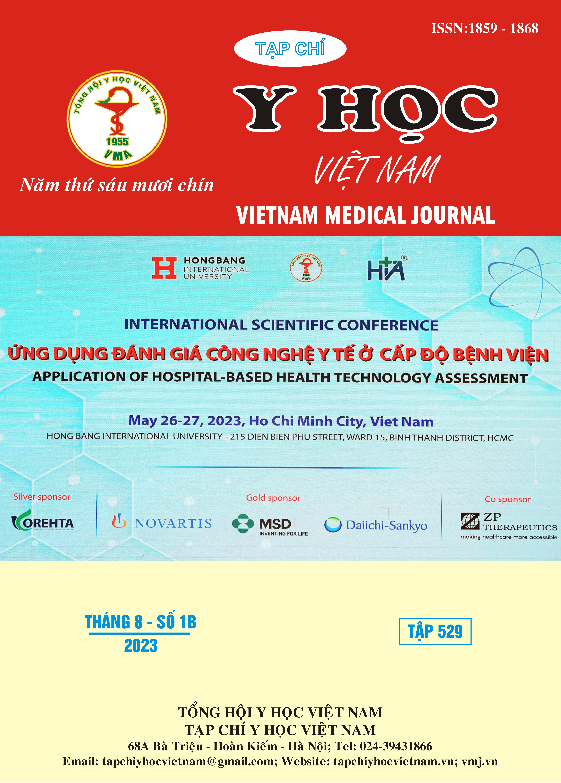ĐÁNH GIÁ KẾT QUẢ ĐIỀU TRỊ PHẪU THUẬT U ĐƯỜNG BÀI XUẤT TIẾT NIỆU TRÊN TẠI BỆNH VIỆN ĐA KHOA TỈNH HÀ GIANG TỪ 2015 ĐẾN 2020
Nội dung chính của bài viết
Tóm tắt
U đường bài xuất tiết niệu trên là một bệnh lý ác tính, hiếm gặp, chỉ chiếm từ 5-10% ung thư biểu mô của toàn bộ đường tiết niệu (đài thận, bể thận, niệu quản, bàng quang và niệu đạo). Tại Bệnh viện Đa khoa tỉnh Hà Giang bệnh lý này khá hiếm gặp ,tuy nhiên chẩn đoán và điều trị còn chưa nhất quán, thống nhất. Vì vậy, chúng tôi tiến hành nghiên cứu với mục tiêu: Đánh giá kết quả điều trị phẫu thuật u đường bài xuất tiết niệu trên tại Bệnh viện đa khoa Tỉnh Hà Giang trong thời gian từ 2015 đến 2020. Đối tượng và phương pháp nghiên cứu: nghiên cứu mô tả cắt ngang hồi cứu toàn bộ bệnh nhân được chẩn đoán là u đường bài xuất tiết niệu trên, được mổ cắt thận niệu quản toàn bộ bằng phương pháp mổ mở trong thời gian nghiên cứu từ 01/01/2015 đến 31/12/2020 tại khoa Ngoại Tổng Hợp và Khoa Ung Bướu Bệnh viện Đa khoa Tỉnh Hà Giang. Kết quả nghiên cứu: U đường bài xuất tiết niệu trên tiết niệu trên gặp chủ yếu ở nhóm tuổi từ 40-60, tuổi trung bình: 50,47 ± 15,29 tuổi; triệu chứng lâm sàng chủ yếu khiến bệnh nhân đi khám bệnh chủ yếu là đau thắt lưng (94,4%), đái máu (80,6%). Phần lớn các tổn thương dưới dạng tổ chức đặc giảm âm và hỗn hợp âm chiếm tỉ lệ lần lượt là 55,6% và 41,7%. Kích thước dọc trung bình của khối u trên siêu âm là 34,7 ± 13,4 mm. 94,4% BN được cắt thận niệu quản toàn bộ, có 2 BN được cắt thận đơn thuần, 1 BN được cắt đoạn niệu quản đơn thuần. Thời gian trung bình của phẫu thuật là 104,1 ± 27,6 phút, ngắn nhất là 60 phút, dài nhất là 180 phút. Chỉ có 1 bệnh nhân bị nhiễm khuẩn vết mổ sau phẫu thuật chiếm 2,8%. Trong số 36 BN sau mổ còn 34 BN liên lạc được, số bệnh nhân đã chết là 3/36 trường hợp (chiếm 8,3%). Số bệnh nhân còn sống là 33 BN, chiếm 91,7%. Có 2/26 bệnh nhân có tái phát tại bàng quang. Đã được xử trí cắt toàn bộ bàng quang đưa niệu quản trái ra da. Không phát hiện bệnh nhân nào có dấu hiệu di căn khối u. Kết luận: U đường bài xuất tiết niệu trên đã được điều trị an toàn và hiệu quả tại Bệnh viện đa khoa tỉnh Hà Giang.
Chi tiết bài viết
Tài liệu tham khảo
2. Chiche R, Boccon - Gibod L, Dalian D, et al (1982). Upper tract urothelial tumors: diagnostic efficiency of radiology and urinary cytology. J Urol, 8(3), 145.
3. Lê Ngọc Từ, Nguyễn Thế Trường, Nguyễn Bửu Triều (2001). Nhận xét đặc điểm lâm sàng và điều trị phẫu thuật ung thư bể thận, Tóm tắt báo cáo Hội nghị khoa học của nghiên cứu sinh, Trường đại học Y Hà Nội.
4. Mazeman E. (1972), “Les tumeurs de la voie excrétrince urinaire supérieure: Calices, bassinet, uretère”, Rapport de I’A.F.U., 66e session, Masson, Paris.
5. Nguyễn Phương Hồng, Nguyễn Quang, Nguyễn Phúc Cương và Nguyễn Sỹ Lánh (2003). Chẩn đoán và xử trí UTBM đường tiết niệu trên (nhân 25 trường hợp), Ngoại khoa, 53, 4, 18-24.
6. Nguyễn Phương Hồng (2016). Nghiên cứu chỉ định và đánh giá kết quả phẫu thuật điều trị ung thư biểu mô nguyên phát đường tiết niệu trên tại bệnh viện Hữu Nghị Việt Đức.Luận văn tiến sĩ y học, Đại học Y Hà Nội.
7. Lê Văn Long (2018). Đánh giá kết quả phẫu thuật ung thư đường bài xuất tiết niệu trên tại bệnh viện Hữu Nghị Việt Đức. Luận văn thạc sĩ y học, Đại học Y Hà Nội.
8. Nguyễn Duy Trí Dũng. Đánh giá kết quả phẫu thuật điều trị ung thư đường bài xuất tiết niệu trên tại bệnh viện Bạch Mai. Luận văn thạc sỹ y học, Trường đại học Y Hà Nội; 2020.


